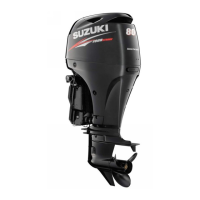Suzuki
Lean
Burn
Control
System
The
lean
burn
control
system
is
designed
to
run
on
a
thinner fuel mixture through the
use
of a
lean
air-fuel ratio.
Suzuki
engineers designed a
system
that predicts
fuel
needs
according to operating conditions. It achieves
added
fuel
economy through a reduction of pumping
loss.
In
order to
balance
fuel
efficiency with
clean
emissions, the
system
sets
up
air-fuel ratio taking
advantage
of the reaction
characteristics of exhaust emissions.
The
system
also
has
a
wide
lean
burn
range
that extends
up
into the top
speed
range
providing
more
efficient operation at cruising
speed
as
well.
Mechanically Efficient
Design
Looking
beyond
fuel
systems
for solutions,
Suzuki
engineers
explored
ways
they could improve efficiency
by
reducing
mechanical
loss.
They
designed a
new
oil
pump
that
delivers greater mechanical efficiency,
and
improved
hydrodynamics
in
the lubrication
system,
allowing
oil
to
move
through the
system
with
less
resistance.
In
reducing
mechanical
loss
in
these
and
other
areas,
Suzuki
has
created a
more
efficient engine that contributes to better
fuel economy
Multi-Point
Sequential
'
Electronic
Fuel
Injection
Multi-Point Sequential
Electronic
Fuel
Injection
The
first generation
DF70
was
awarded
the
National
Marine
Manufacturers Association's Innovation
Award
for,
among
other firsts
and
advancements, its
use
of Suzuki's Multi-Point
Sequential Electronic
Fuel
Injection
system.
The
second
generation
DF70/80/90
use
this sophisticated
system
once
again
to deliver instant throttle
response,
improved
fuel
economy,
and
low
emissions.
The
system
uses
the
ECM's
32-bit
computer,
which gathers
and
processes
vital operating
data
in
real
time
from
a
series
of
sensors
located
in
critical
areas
on
the
engine,
to calculate
the
optimum amount of
fuel
and
air
to
be
injected at
high
pressure
into
the
cylinders.
The
system
offers excellent
fuel
efficiency
and
reduces
emissions
enabling these
outboards to meet
Comparison
of
Fuel Consumption
1{.'tII
CARB
2008,
the
world's strictest
''''!!ii.I'y//
/
emissions regula-
tions.
Other
benefits include
"Iii;·
!L
IVN"
111&
smooth starts,
and
maximum
oper-
ating efficiency.
'.',r.
Hl~h
(IDm)
EllhllustJackel
Temp
sensor
I
(~
J
~:~~~I~PoSillon
~
P
Sintor)
.0
"T.~-
I
II
I'
U
nun.
Y I I
"~J
7 Mlnifold
Absolul~
Pre-,.ule!'
s'nsol
7 (MAP
Sinsot)
Th'o1UC!'
Position
Sensor
3

